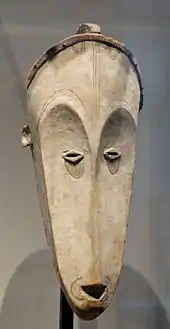芳人
芳人(Fang),非洲中西部民族,屬於班圖尼格羅人種,又稱帕胡因人(Pahouin)、龐圭人、芳維人。主要分布在喀麥隆南部、赤道幾內亞、加彭北部以及剛果部分地區[1]。使用芳語,屬於尼日爾-科爾多凡語系西北班圖語群。使用拉丁字母拼寫的文字。多信萬物有靈,崇拜祖先、土地神和水神,部分人信基督教。共分 6 個部族、112 個部落 ,其中:埃翁多族有22個部落;貝內族有14個部落;布盧族有11個部落;恩圖穆族有26個部落;姆韋族有13個部落;有26個部落。以父系氏族為基礎,社會組織分為家庭、村莊、家族、氏族4級。實行一夫多妻制。主要種植木薯、芋頭、玉米和芭蕉,兼事狩獵和採集。民間藝術與原始宗教信仰有密切關係,主要為造型藝術和面具雕刻等。村落中均有一座造型別緻的公房,供全村用於開會議事、接待客人或娛樂活動。
| 芳人 | |
|---|---|
 4-faced Ngontang mask of Fang people | |
| 總人口 | |
| 約100萬[1] | |
| 分佈地區 | |
| 喀麥隆南部、赤道幾內亞、加彭北部、剛果部分地區 | |
| 語言 | |
| 芳語[2] | |
| 宗教信仰 | |
| 泛靈信仰、基督教 | |
| 相关族群 | |
| Beti people、Yaunde people |
民族分布、人口與語言
芳人分布在喀麥隆南部(160萬)、赤道幾內亞(25萬)、加彭北部(35萬)以及剛果部分地區,總人口大約為221萬人。芳人使用芳語,其屬於尼日爾-科爾多凡語系西北班圖語群。而文字上使用拉丁字母拼寫的文字[3]。
地理環境
芳人分布的地區大多為炎熱、潮濕的赤道雨林。
歷史沿革
18世紀末時芳人從薩納加河右岸熱帶草原地區南遷至沿海雨林區。而後在19世紀末起先后遭受德國(1887)[4] 、法國(1916)[5]的殖民統治。殖民統治結束後,在1960年起先後獲得所在國的國家獨立。[6]
社會、家庭、婚姻
芳人為父系社會,其社會組織分為家庭、村莊、家族、氏族4級,組成方式為幾個共同血統的家庭住在同一個村莊,而幾個相近血統的村莊組成 一個家族(氏族)。其中氏族由酋長所領導,這位酋長擁有宗教權威。家族則是由年長者作為家族首領,在家族中無等級制度。村莊的領導者為世襲的,為建立起村莊的家庭成員後代擔任。這種制度到現在領導者權力已變小,決策改由共識來決定。芳人實行一夫多妻制,在此制度下男女關係不平等,產生了他們友誼比愛情高貴的想法。[7]
產業與生活
芳人的主食為木薯、芋頭、玉米,而因為殖民地的背景種植巴蕉、可可、花生、棕櫚等經濟作物,擁有最密集的種植園[8],並兼事狩獵和採集。芳人沒有固定的吃飯時間,食物的多寡是唯一限制,有東西就吃,吃到沒有食物就停止。[9] 在殖民統治下對外貿易木頭、象牙。 芳人的住宅為長方形茅屋,一般有兩處,一處位於道路邊並與道路平行、背對森林,另一處位於林間空地的農作物旁。而在村落裡面有一個特別漂亮、寬敞的公房,供全村用於開會議事、接待客人、調解糾紛或從事娛樂活動。
信仰與習俗
.jpg.webp)
芳人被認為是具有侵略性的勇士,在17世紀以前有吃人肉的習俗。芳人相信祖先的骨頭含有和其在世時相同的能量,所以會將祖先的骨頭放進木頭盒子中保存。[10]在宗教上信奉泛靈信仰,他們崇拜祖先、土地神和水神,並會用巫術懲罰有罪之人[11],然而有部分人信奉基督教。
文學與藝術

芳人的藝術與原始宗教有密切關係,主要為造型藝術和面具雕刻,其面具使用為領導者戴上面具後能藉此和祖先溝通,並也能用於狩獵儀式。現在這項技藝已漸漸沒落,故傳教士鼓勵雕刻師做面具,把眼光看向新興的觀光業,面具便淪為觀光市場的產品。[12][13]
跟当地其他族群相比,芳人更重视教育,文化层次普遍较高,多从事文职类工作,收入和社会地位也明显要高一些。
著名人士
加彭首任總統萊昂·姆巴為芳人。 赤道几内亚首任总统弗朗西斯科·马西埃·恩圭马是芳族。
參考資料
- Anthony Appiah; Henry Louis Gates. . Oxford University Press. 2010: 415–419, 460 [2017-03-17]. ISBN 978-0-19-533770-9. (原始内容存档于2017-03-23).
- Fang (页面存档备份,存于), Ethnologue
- 世界民族博览社 (编). . 北京:知识出版社. 1994年6月: 164. ISBN 7-5015-5601-6.
- Beginning in 1887, German colonisers penetrated Beti-Pahuin territory to search for individuals to enslave on their coastal plantations Beti-Pahuin_peoples Colonial period
- French colonial rule of Cameroon began in 1916 and largely followed in the German mold. Beti-Pahuin_peoples Colonial period
- Since the end of the colonial period in the 1960s, the Beti-Pahuin have succeeded in making themselves politically important in both Cameroon and Equatorial Guinea. Beti-Pahuin_peoples Post-independence
- Of the Fang (Gaboon) it is said: “The marriage relation dominates all customs, and is the foundation of the whole social structure. With the African, love is not so closely linked with sex as among Western races. Friendship is deemed nobler than romantic love. This, of course, is due to the inequality of the sexes; a woman is not regarded as fit for companionship with men “Fetish Folk of West Africa”, p. 132
- Most of these are Bulus or Fangs, since their territory contains the largest concentration of plantations. Beti-Pahuin_peoples
- The Fang have no regular time for eating; and when they have begun to eat there is no regular time for stopping. The quantity of food is the only limit. On a long journey they can go without food a very long time, far surpassing the endurance of a white man. And they are often compelled to travel with empty stomachs from their habit of eating all their food the first day.—“Fetish Folk of West Africa,” p. 117.
- . [2015-06-11]. (原始内容存档于2021-02-13).
- A firm belief in witchcraft also persists among much of the population, and even today, sorcery is a punishable offense in some areas. Beti-Pahuin_peoples
- Today, however, very little of this traditional craft is still pursued, though missionary groups have encouraged some carvers to continue to practice with an eye toward the tourist market. Beti-Pahuin_peoples
- . [2015-06-11]. (原始内容存档于2021-01-18).